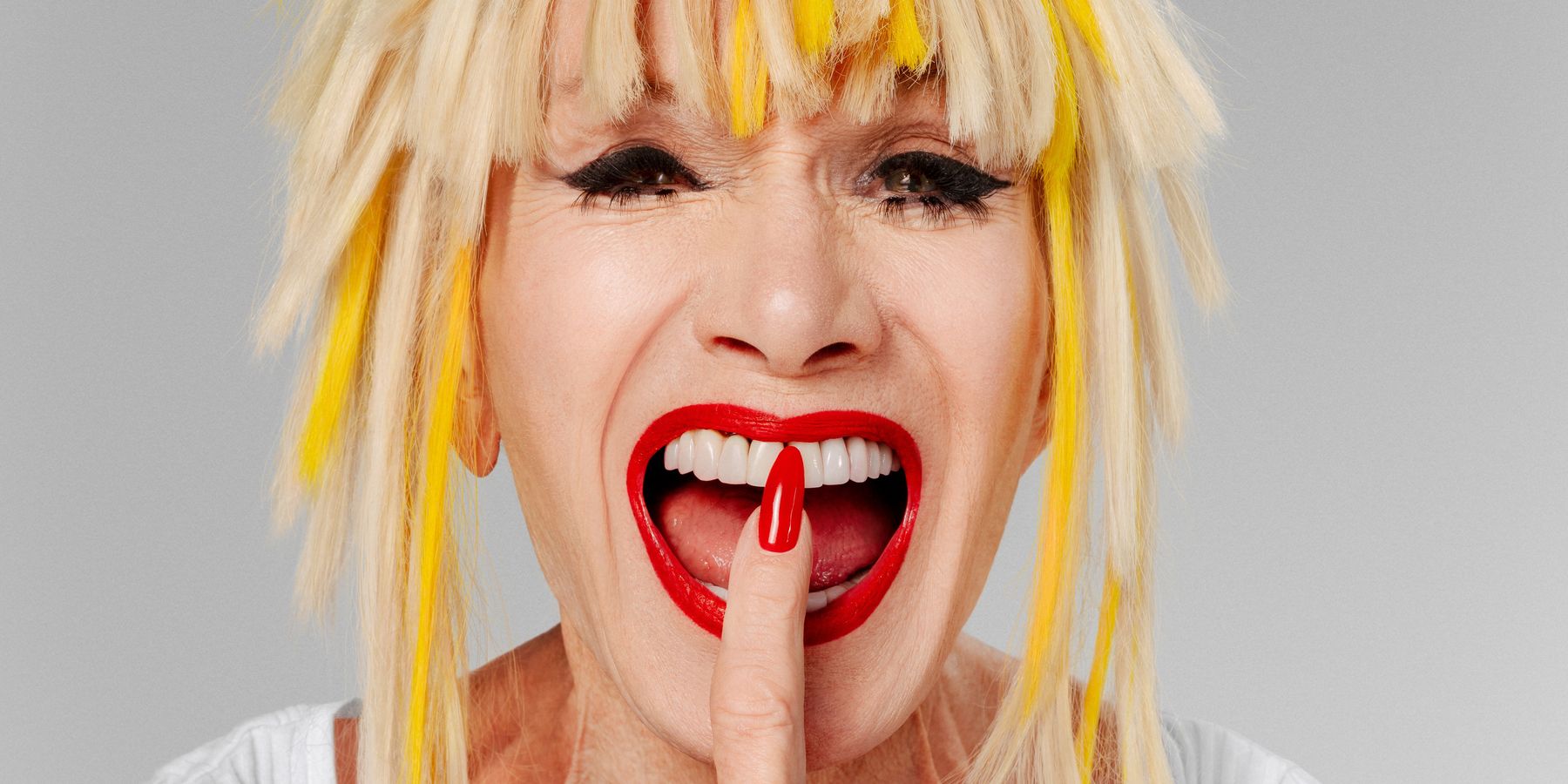
Long Live Betsey Johnson
Story by Liana Satenstein / Photography by Ryan Duffin / Styling by Katie Qian / Hair by Ted Gibson / Makeup by Kristin Gallegos

Betsey Johnson knows how to deliver a quote. After all, she’s been doing this for quite some time. Once the 81-year-old designer asks my name, she casually drops an anvil statement. “I just looked at my will this morning,” she says in a matter-of-fact way. “Which is really shocking.” A will? Betsey Johnson? The babe-beloved designer who perpetually lives in a Neverland kaleidoscope of frills, ruffles and freakadelic prints? The woman who still flies in from the tricked-out, floral-slathered walls of her 2,300-square-foot mobile home in Malibu to the storied Chelsea Hotel to get her flamboyant hair extensions glued in — two days, four to five hours each session! — by Andrew, the same guy she’s been going to since the mid-'90s? Her TikTok is taking off with young hot things waxing poetic about discovering saucy pieces for the very first time! Hell, Olivia Rodrigo just wore one of her vintage lace-trimmed pink slip dresses a few months ago.
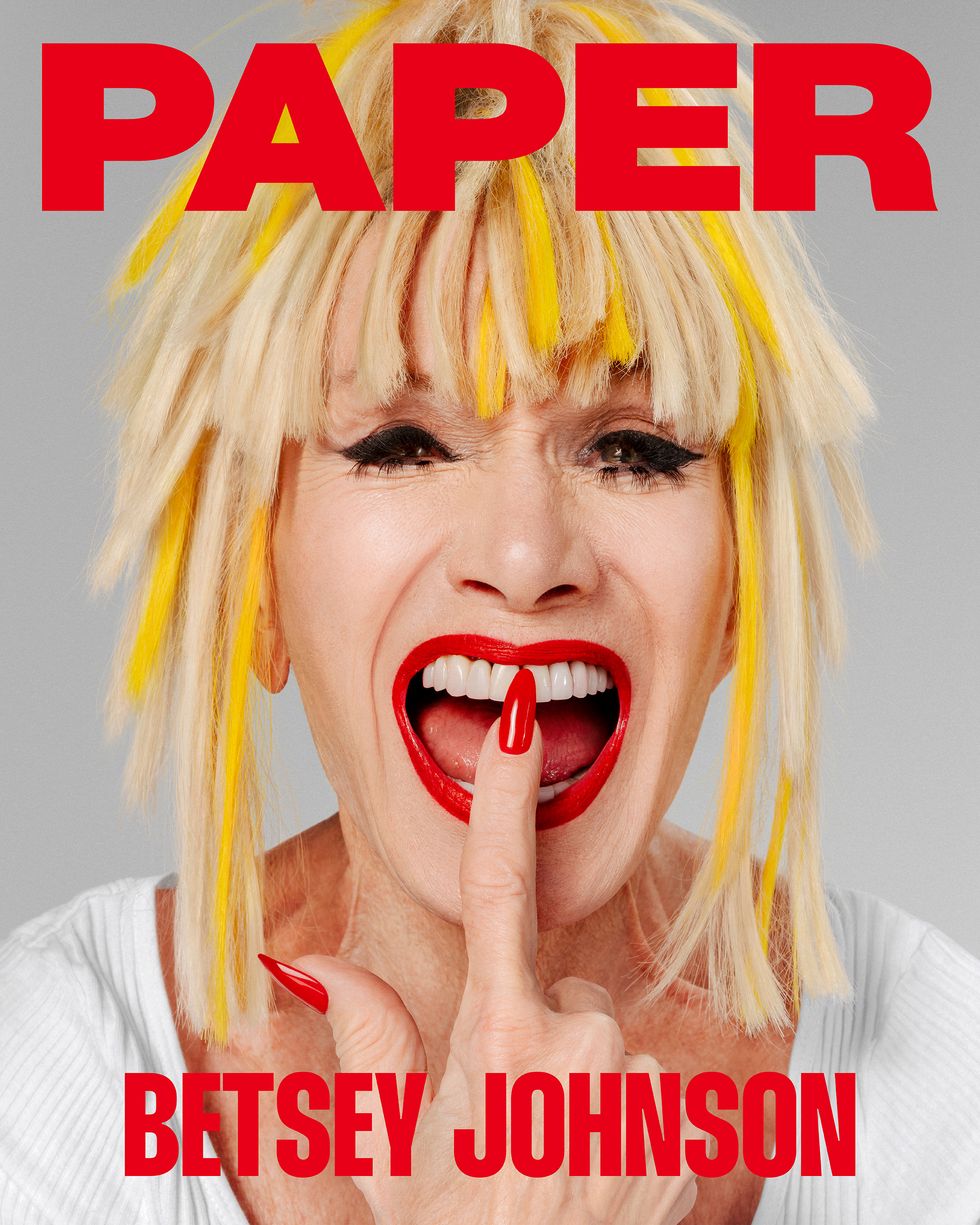
Okay, don’t worry. The will is just a formality. And Johnson hasn’t even really dug into the will. “I held the envelope and saw the piece of paper,” she says. Johnson, who says “she has never looked better” and “eats so healthy, it’s a joke,” is living and loving life.
In fact, it seems as if Johnson has lived a hundred lives — and it feels like generations of us have lived them alongside her. This past fashion week at a sought-after downtown show, I sat next to 30-something-year-old writer Emilia Petrarca who told me about a newspaper print Betsey Johnson set that she wore for her interview at The Cut. “It was all women’s magazines,” she says about the print. “I liked that it wasn’t a newspaper print that was Galliano and it was specifically women’s magazines. It felt more feminine.” And the dress worked. Petrarca got the job. (She wore a Tibi dress to a Vogue internship interview. Petrarca did not get that position). Later at the same show, I ran into bonafide fashion royalty Lynn Yaeger, who got her start writing for The Village Voice back in 1978. She mused about Johnson, who lived the floor above her on Fifth Avenue back in the day. “I was a huge fan and a customer before I met her. I was excited to meet her, but it felt like I already knew her for a long time,” Yaeger says. “It captured that women can be strong and wear ruffles... she was way ahead. The same thing Batsheva and Simone [Rocha] do now.” Designer Batsheva Hay herself would take the bus in from Queens to go to Johnson’s store next to Bloomingdale’s. “It felt like the first cool thing I could get my hands on; the first fantasy thing I could get my hands on,” Hay says. “It was like Laura Ashley, but way more twisted and fun.”
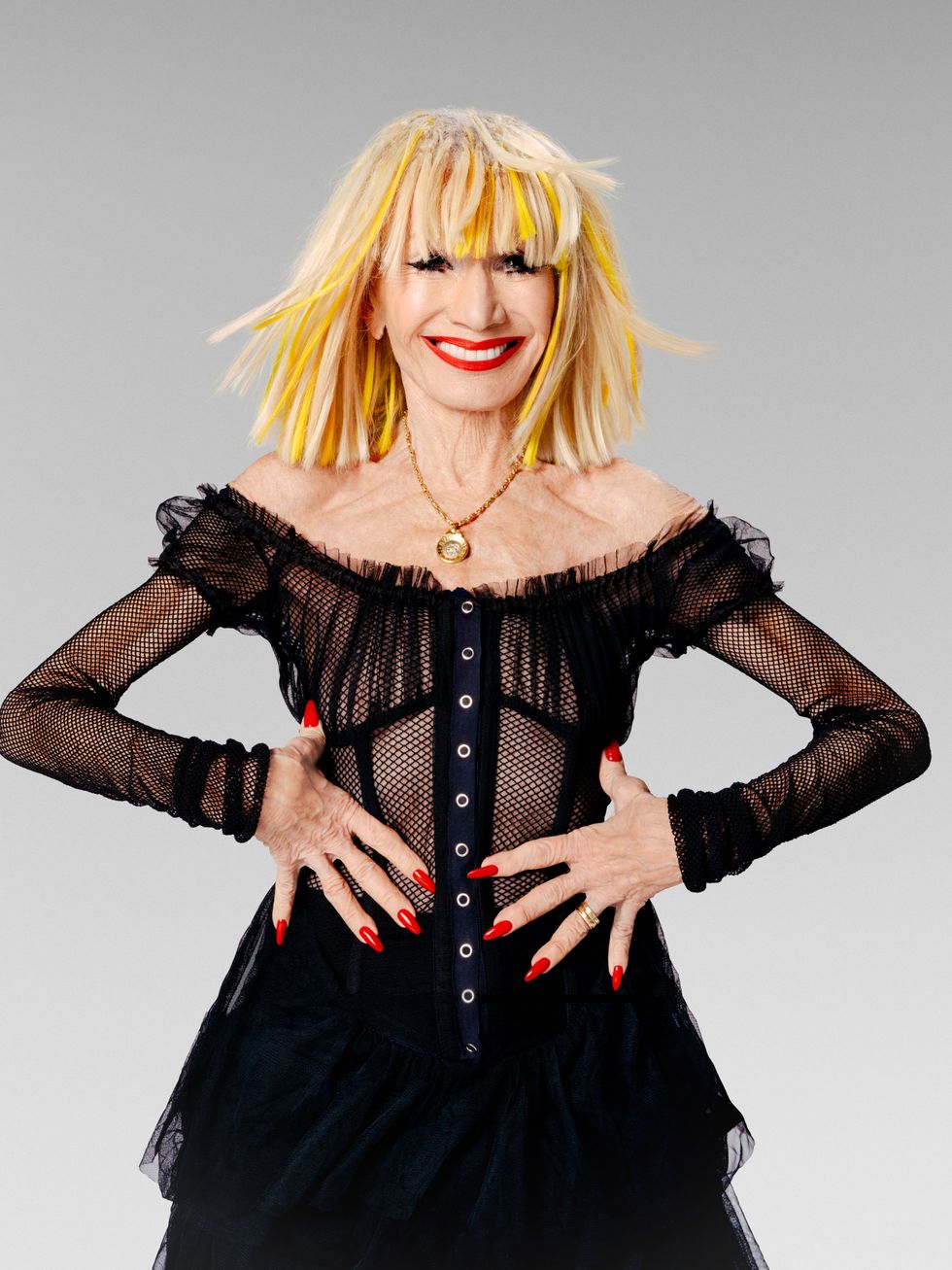
Clothing: Betsey Johnson, Necklace: Bulgari
Everyone has a memory about Betsey Johnson. I remember being a child in a small town in Massachusetts and seeing her do signature cartwheels down the runway, late at night on FashionTelevision. Or maybe it was E! I’m not totally sure. After all, Johnson may have very well not been on FashionTelevision; she had always been considered an outsider in fashion, someone who managed to burst her way into the industry thanks to the impossible-to-miss fanfare that followed her. Her formula, if you could call it that, wasn’t getting on the good side of the press, but rather getting the customer first. “I know they want me to tell my story of how I did it, so the kids can get the formula,” Johnson says about when she has been asked to give lectures to students. “And I was just surprised because there was no formula.” That’s innate thinking; honest thinking; no media-savvy strategy thinking. Instead of going the industry with a capital I route first, Johnson started her business by entering the hearts of her fans and creating clothes she wanted for herself. “I didn’t even think who my market was. I just figured I'll make clothes for me,” she says. “And I hoped that would be right.”
The clothes are certainly fun; they are made to be worn with a full-fledged joyousness. They have neither a lascivious nor sensual sexual appeal, but rather a brusque sass that is endearing. The pieces, in all of their raging colors and funky accoutrement trimmings, beg for someone to play dress-up in them; fit for a type of girl who views the world in psychedelic rose-tinted glasses, and moves through it in a killer floral soaked slip dress. Even in the ’60s, during her beginning days designing creations for the Paraphernalia boutique, she whipped up little strappy dresses that hugged the body, complete with ribcage-skimming slits that were on both sides of the body. (Penelope Tree wore this design in black, which is displayed at The Met). A clear vinyl halter dress with a DIY kit of cut-out space-age decorations, like silver stars and metallic rays. And, of course, her mini skirts caused a hooplah during the ’60s and got her a mention in a 1966 issue of The New York Times in which she said older cab drivers always had something snarky to say about her bare knees. Quel horreur!
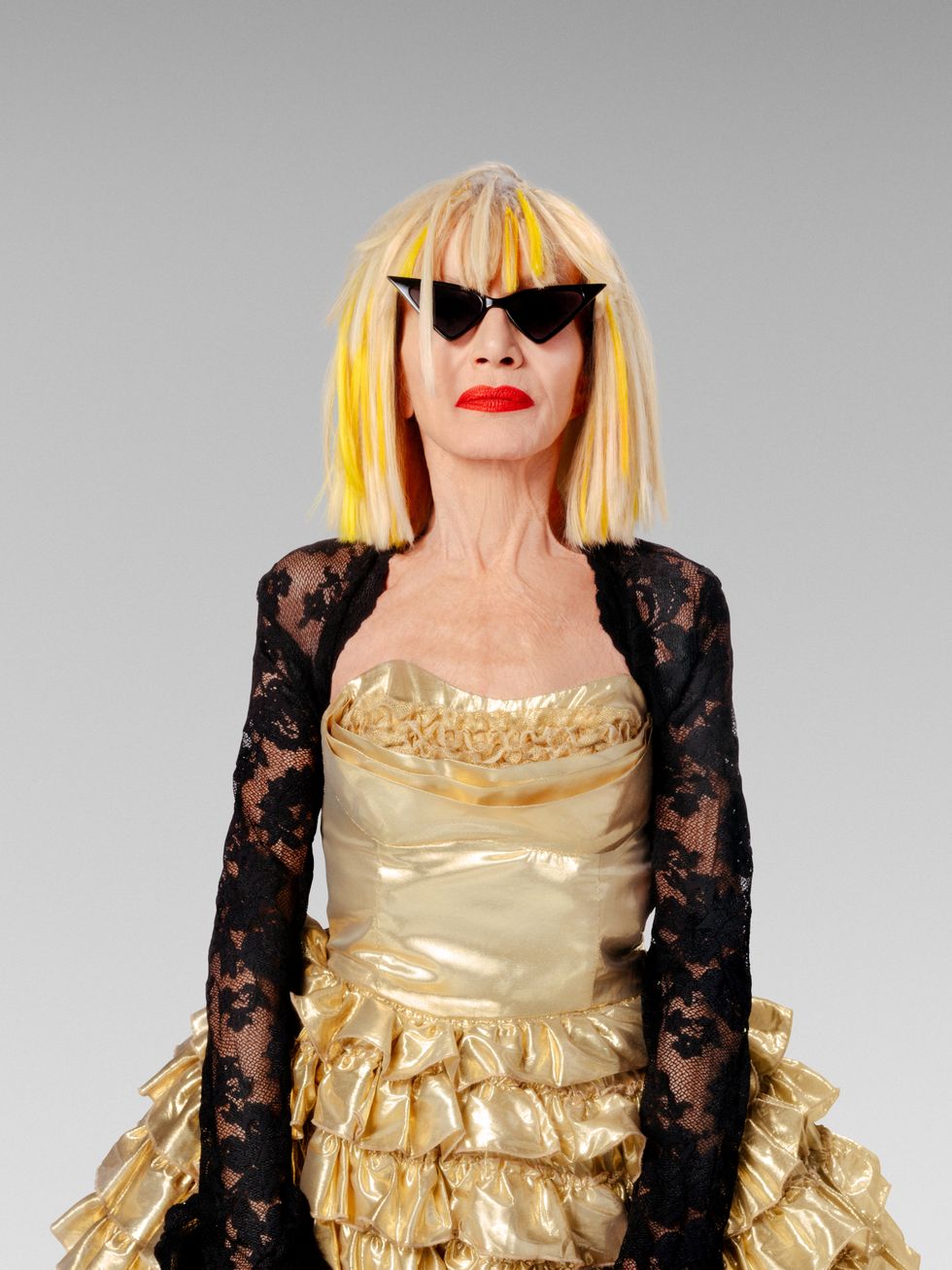
Clothing and sunglasses: Betsey Johnson
That lust for exuberance followed Johnson into the mid-’90s and early ’00s, into proms and Bat Mitzvahs and parties. The dresses were flouncy, bouncy and full of tulle in every searing color of the rainbow. Women flocked to wear her itty bitty juice-hued cardigans; two-piece milkmaid sets covered in dainty florals; rocker chick takes on capris, fine-inducingly low-slung. Destiny’s Child wore her tattoo-print slinky dresses; a teen Natalie Portman wore a lace-up black dress with a hoop skirt; Gwen Stefani wore a pale robin egg blue halter on the cover of No Doubt’s Return to Saturn. Her shows were a thematic hoot; the original ‘core-dom with blown-out proms, sexy maid outfits, rocker babes, slinky boudoir moments. Johnson had her very own store employees — from receptionist to someone heading up PR, tattooed, tiny or curvy — strutting the runway in her looks. Johnson hired fun; she delivered fun. She lived fun.
Johnson, like many of her dedicated fans, had always been a dreamer, someone who walked to the beat of their own peppy drum. She grew up in quiet Westfield, Connecticut. “I remember it as farmlands,” she says. “It was cornball, but warm and wonderful and neighborly and gardens and sharing. All that really old-fashioned stuff.” As a child, her mother sewed about half of her wardrobe, noting, “We didn’t go into Hartford to go buy clothes.” Her mother also made her dance clothes, quite intricately by layering on the tulle and sequins, which Johnson says “will always be my biggest inspiration, along with Old Hollywood movies.” Johnson, an avid dancer, began dancing at four and five, taking lessons about four or five times a week, which became a full-fledged apex of fantasy for a young Johnson. “It consumed 95% of my body and 95% of my head,” she says. Dreaming started with dance, namely her teacher who was a Broadway dancer: “a total fantasy lady.” The recitals and costumes typically were food-oriented themes. “I have strawberry shortcake, Neapolitan and vanilla-chocolate costumes,” says Johnson of her still-saved costumes. Later for her own runway shows, themes would be explosive, alluring and a party in their own right.
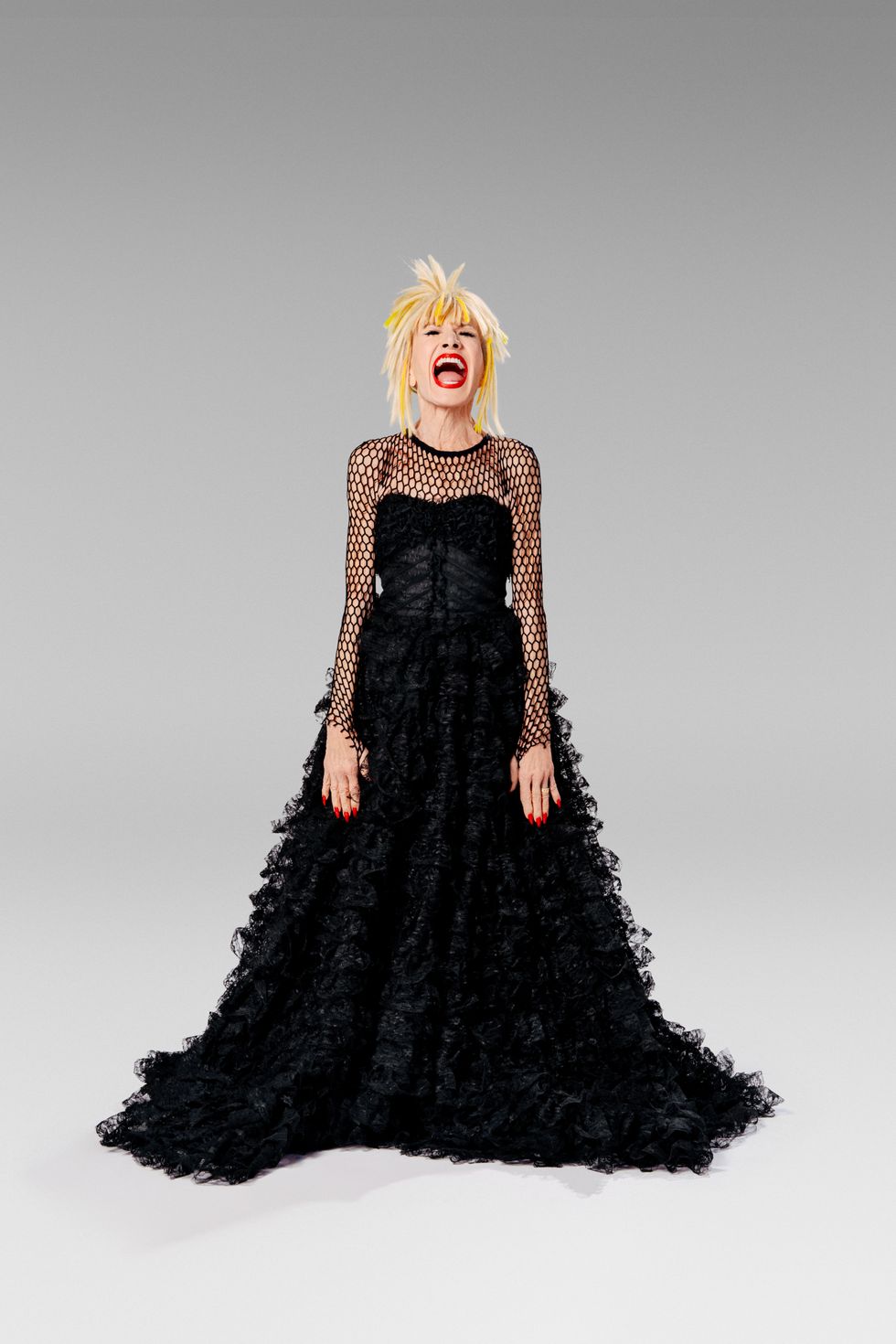
Clothing: Betsey Johnson
Her teacher inspired Johnson to want to move to New York, where she attended Pratt in Brooklyn. Johnson wanted to dance at the same time, while also joining the cheerleading squad: “I made the cheerleading squad and that was like the ugliest, the worst, most embarrassing thing you could be as an art student.” She then went to Syracuse University, became head of the cheerleading squad and gave up on her Broadway moment. “I was screaming my lungs out cheerleading, so the dancing part fell apart,” she says. “I wasn’t trained enough, talented enough and too short.”
Marooned in upstate New York, Johnson still wanted to come to the city. It wasn’t until she entered a contest for a summer scholarship at Mademoiselle that she felt her luck panning out. She worked at the magazine while living at the now-closed Upper East Side’s Barbizon Hotel, temporary women’s lodging that housed the likes of Farrah Fawcett, Joan Didion and Nancy Reagan. “That was the turning point,” Johnson says. “That was the huge foot-in-the-door gig.” There, she did several different things, including working in the fabrics and art production departments where she excelled. “I could draw ugly things and make them look good.”
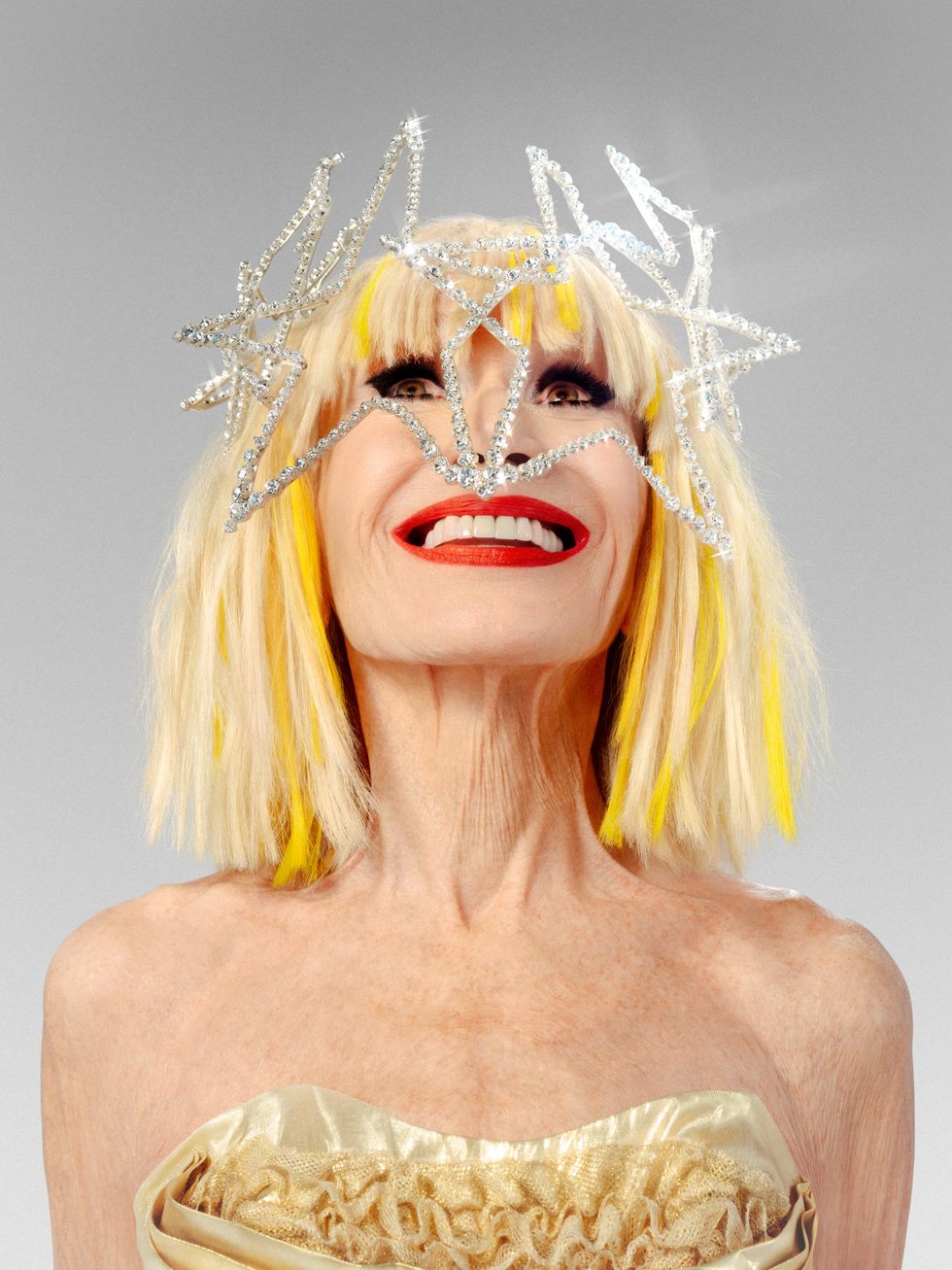
Clothing: Betsey Johnson, Headpiece: Piers Atkinson
As luck would have it, Johnson didn’t end up finishing her internship, but was able to stay on in a guest editor role when an editor went on maternity leave. Since leaving the Barbizon Hotel, and now renting, she had to make money. Johnson began making sweaters on the side. “It was a hand-crocheted fabric that I cut and sewed. I put a little velvet ribbon around the neck and a little velvet bow and a little card that said ‘I hope you like my sweater.’ Every weekend I would have to make about 30 sweaters by hand, so I had this little business,” Johnson says. “I didn’t know what I was doing or where it was going, but something was happening.” Mademoiselle editors Edie Locke and Betsey Blackwell suggested that Johnson leave the magazine and venture into fashion design.
At Mademoiselle, she was introduced to Paul Young, who had the idea for Paraphernalia: a store that would “cater to the young, rich girls in New York.” Johnson went to the interview with two suitcases filled with clothes that she had made for her fellow fashion editors, “which is the only way to give an interview.” She got the job designing for the boutique and, by the mid-’60s, the destination brimming with her off-kilter designs was a hit. Johnson met Andy Warhol, as well as The Velvet Underground, through her work at Paraphernalia, for whom she made costumes. (She married the band’s founding member, John Cale). An article in The New York Times from 1966 shows Johnson in a chalk-pinstripe suit, standing with a male model in a flowered vest and velvet suit, with a quote that reads, “Miss Johnson, who at 23, is better known to the young than Balenciaga.” Everyone went to Paraphernalia for the freaky-deaky mod pieces, including the kicky mini skirts. Raquel Welch. Bobbie Gentry. Edie Sedgwick was Johnson’s fit model. And it was affordable, an ethos that has long been associated with her namesake label.
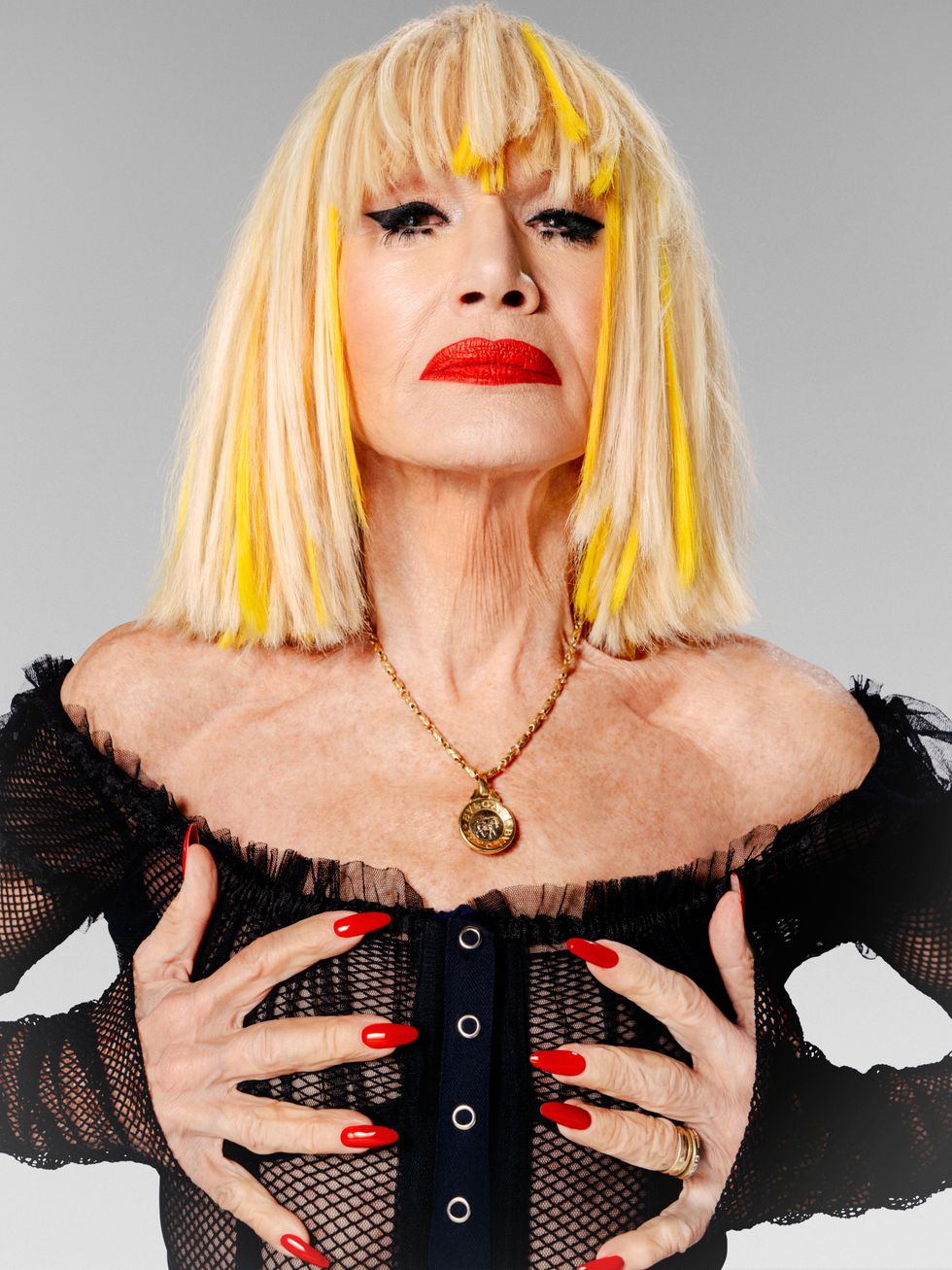
Clothing: Betsey Johnson, Necklace: Bulgari
Johnson eventually left Paraphernalia. She held a multitude of gigs: a freelance designer who created a kid’s line, designing for Betsey Bunki and Nini, a store that Johnson opened with two other women on the Upper East Side. In the mid-’70s, she also started designing for the junior’s line Alley Cat, where she met business partner Chantal Bacon. One killer piece, a quilted corduroy coat with hulking black faux fur sleeves, is in the FIDM Museum. (You can also still find the print-centric Alley Cat dresses on eBay for a pretty penny.) “I did all my artwork on a little tiny square graph; no computers at that time at all. I would do my artwork and my drawings of nature. I would illustrate birds and bees and landscapes and Grand Canyons and cornball kittens and doggies. I did all that.” Her first runway collection for Alley Cat, which recalled the themed recitals of her dance teacher, was a wedding in which Johnson married a man dressed up in a cat mascot costume. In 1971, those pieces won Johnson a Coty Winnie Award, alongside Halston.
In 1977, Johnson launched her namesake label. Then, the Betsey Boom became very real. Her clothes were delicious; lapped up by fangirls and sweet things who wanted a piece of Johnson’s confectionary universe. The shows were sassy and dripping with pizazz. Models skipping in her skin-tight dresses, slipping silk mini skirts off their bodies and swiveling their hips in hooded bodysuits. The success followed the designer into the ’90s and early ’00s. Babydoll dresses. Raucous shows. Hot shorts.
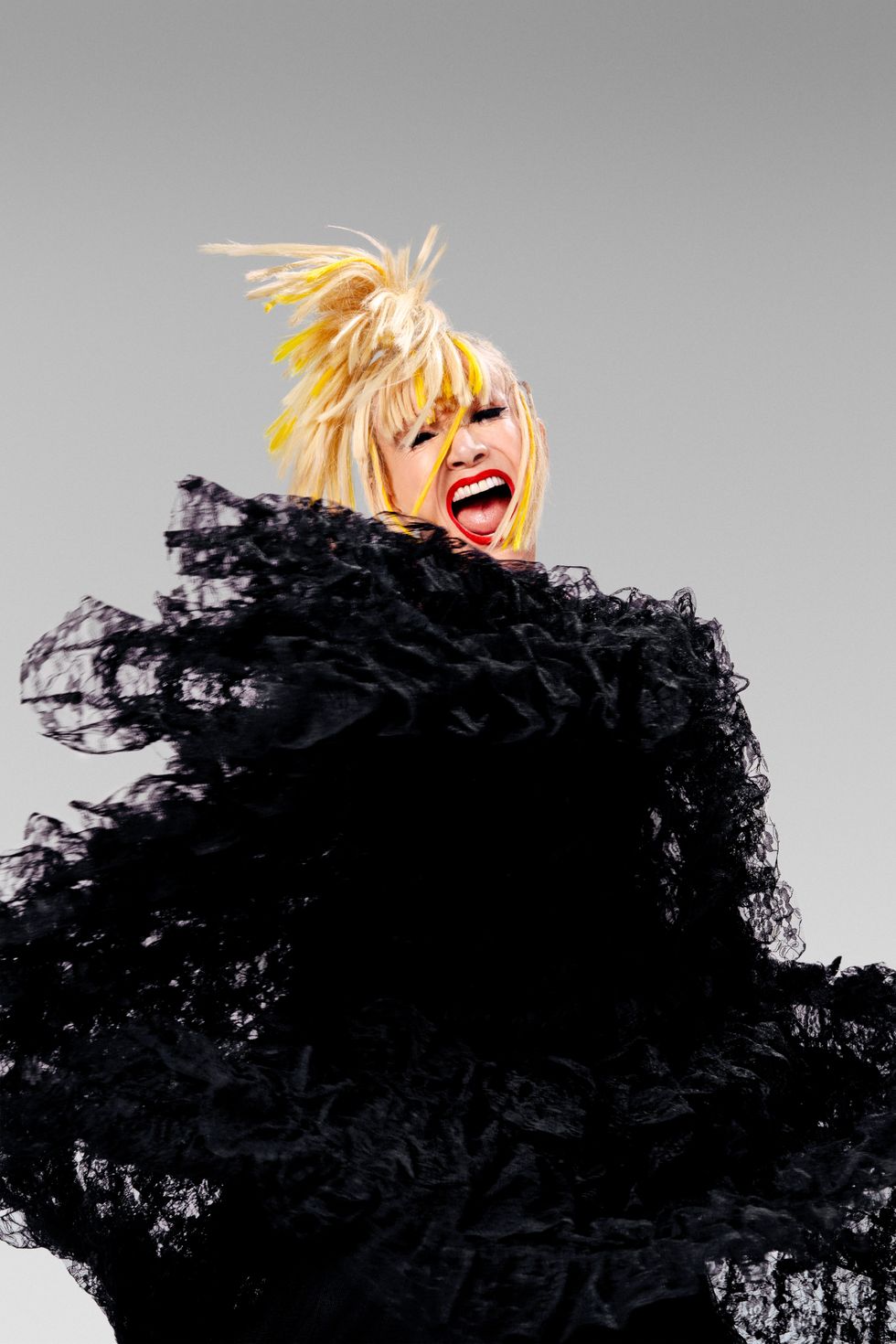
Clothing: Betsey Johnson
In the 1992 October issue of Vogue, shot by Steven Meisel, Madonna evoked Janis Joplin in a Betsey Johnson black lace tie top. But aside from some mentions in Vogue, one of Johnson’s biggest moments in the magazine is in an advertisement from 2006. The designer is in a gold sequin-slathered mini dress riding a swan, holding a bottle of Betsey Johnson perfume. The bottle looks like a tsar crown fragment, her colorful extensions flailing in the heavenly wind. Johnson appears wide-eyed with happiness coursing through her veins. Absolutely elated, as if she’s high on stratosphere fumes.
Sure, her designs were scattered in the pages of Vogue, but Johnson was never quite in Vogue. No hefty profiles. No real deep dives. A 1987 article in The New York Times wrote that she had angered the press by cramming them into her tiny showroom on 7th Avenue. “I knew I had to stop making people suffer,” she said about her decision to move her show to the Parsons School of Design. But that was the thing; the girls loved Betsey, but the industry wasn’t alway signed on. “The most important thing I love about Betsey is that she was really happy and very unpretentious. I think especially to someone who is not an insider in New York and in fashion, that can seem very exclusive and too expensive and too mean and too not cool enough,” Hay says. “Betsey always seemed happy and inclusive, and that brand had the ethos to it.”
And perhaps being an outsider is what makes Johnson so fabulous. What better way to see your pieces being worn in the streets and at events by real people instead of marooned in an editorial ivory tower? PAPER co-founder Kim Hastreiter, who worked at Johnson’s Betsey Bunky Nini, weighs in. “She wasn’t who the fashion world likes to pick, like trendy people. They want someone that's hot at this moment; either really rich or someone that's really connected. She just didn’t fit in anywhere,” Hastreiter says. Fashion loves a heady designer full of references and moodiness, but Johnson was different, almost approaching design with a childlike wonder. “She started to open stores, which was the smartest idea, because then it was like Betsey’s world,” Hastreiter adds.
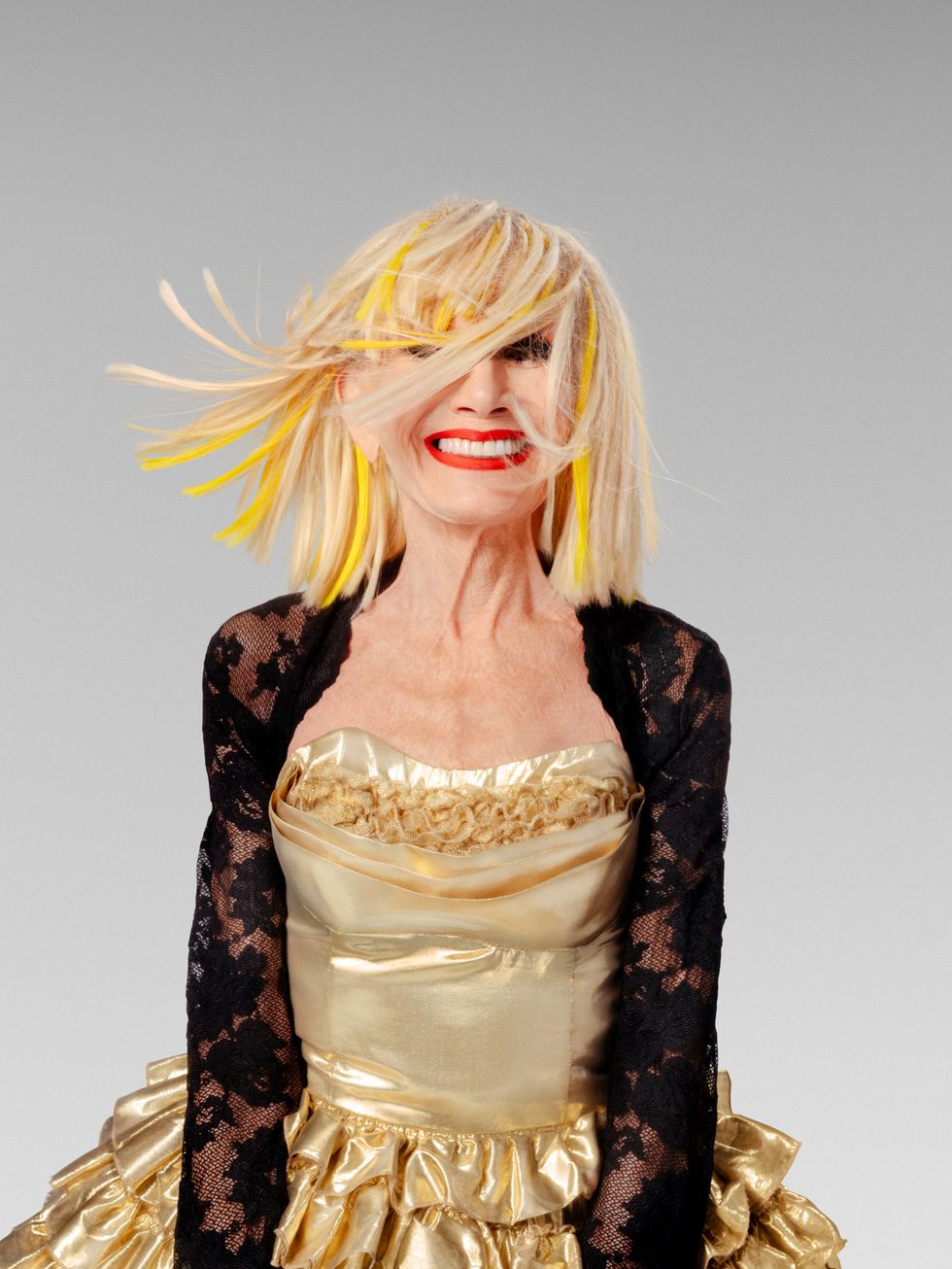
Clothing : Betsey Johnson
Despite her perpetually upbeat attitude, Johnson has had her fair share of tough times. Hastreiter recalls that Johnson, during her beginnings, must have “gone out of business probably a million times.” The designer also underwent open heart surgery and had breast cancer. “I didn’t tell anyone, which is probably the secret,” Johnson says. “It would have been a real downer with people feeling sorry for me.” Johnson never has a faltering tone when she speaks, even about the bad stuff.
Johnson’s frenzied jubilance has always trickled into the designs, consistently. It’s helped keep the vintage iterations of the brand still sought-after. The label, which went bankrupt in 2010 and was bought by Steve Madden, is yet again having a major comeback. There is a reason why girls are pulling Johnson’s Y2K designs from their mother’s closets or feverishly searching resale sites. The pieces are unlikely classics and an instant dopamine kick. Last year, Olivia Rodrigo wore a Betsey Johnson slip dress, which was the epitome of a teen dream uniform: A bust criss-crossed with pink lace and the rest in a dainty floral print. The Hollywood dress has made rounds on TikTok, much to the credit of Betseyphile and avid collector Steph Ermer. Crushed velvet. Lace trim. Yummy prints. “I love that for so many iconic Betsey collections, there was always a Hollywood dress that went along with it,” Ermer says. “It’s always the perfect marriage of feminine and grunge, which is quintessential Betsey.”
A few months ago, Johnson hosted the event “Luv Urself” in Los Angeles alongside social media star Gabbriette and her impossibly thin eyebrows. The Betsey Johnson TikTok itself is loaded with iconic moments, both from collectors and pop culture and Johnson cameos herself. She may only be doing her splits now in lieu of cartwheels — she doesn’t want to slip — but Johnson is unstoppable, and even mentions she wants to get into designing swimwear.
Once again, Johnson has begun to enter the fashion lexicon, guns blazing, but how could she not? After all, why would anyone want to look sad, when they could put on a Betsey Johnson dress and look happy?
Photography: Ryan Duffin
Styling: Katie Qian
Hair: Ted Gibson
Makeup: Kristin Gallegos (using Le Métier de Beauté)
Photo assistant: Luke Austin
Styling assistant: Athena Devajm
Retouching: Zach Vitale
Editor-in-chief: Justin Moran
Managing editor: Matt Wille
Fashion editor: Andrew Nguyen
Editorial producer: Angelina Cantú
Cover type: Jewel Baek
Story: Liana Satenstein
Publisher: Brian Calle
Special thanks to James DeMolet and Steve Madden